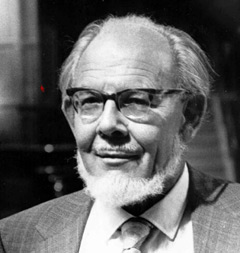Frederick Charles Frank facts for kids
Quick facts for kids
Frederick Charles Frank
|
|
|---|---|
 |
|
| Born | 6 March 1911 |
| Died | 5 April 1998 (aged 87) |
| Alma mater | Lincoln College, Oxford (B.A., 1932; B.Sc., 1933; Ph.D, 1937) |
| Known for | Cyclol hypothesis Disclination Muon-catalyzed fusion Screw disclocation Burton–Cabrera–Frank model Frank partial dislocations Frank's constant Frank free energy Frank–Kasper phases Frank–Read source Frank–Van der Merwe growth |
| Awards | Copley Medal (1994) Guthrie Medal (1982) Gregori Aminoff Prize (1981) Bakerian Medal (1973) Griffith Medal (1967) Holweck Medal (1963) |
| Scientific career | |
| Fields | Theoretical physics |
| Institutions | University of Bristol |
Sir Frederick Charles Frank (born March 6, 1911 – died April 5, 1998) was a brilliant British scientist. He was a theoretical physicist, which means he used math and ideas to understand how things work. He is famous for his important discoveries about how crystals grow and how materials behave. He also studied liquid crystals, which are used in screens like those on your phone!
Contents
Early Life and Learning
Frederick Frank was born in Durban, South Africa. His parents moved back to England soon after. He went to schools called Thetford Grammar School and Ipswich School. Later, he studied chemistry at Lincoln College, Oxford University. He earned a special advanced degree called a doctorate there.
A Career in Science
Before World War II, Frederick Frank worked as a physicist in Berlin. He also worked as a chemist in Cambridge, England.
Working During World War II
During World War II, he joined a special station that dealt with chemical defense. In 1940, he moved to a different department. This department focused on science for the Air Ministry. He stayed there for the rest of the war. Because of his important work, he received an award in 1946.
Research at Bristol University
After the war, he moved to the University of Bristol. He joined the Physics Department there. He started researching how solids behave. Soon, he focused on tiny flaws inside crystals called dislocations.
Understanding Crystal Growth
He worked with other scientists, William Keith Burton and Nicolás Cabrera. Together, they showed how these tiny flaws (dislocations) help crystals grow. This was a very important discovery.
Other Research Ideas
Frederick Frank had many different interests in science. At Bristol, he also studied:
- How plastics and other polymers behave.
- The science behind liquid crystals.
- How the inside of the Earth works.
- Why living things often have a specific "handedness" (like how some molecules are always left-handed or right-handed). This is called homochirality.
He became a professor at the University of Bristol. He retired in 1976. Even after retiring, he kept working on science. He went to conferences and wrote papers. He continued to work well into his eighties.
Awards and Special Honors
Frederick Frank received many honors for his scientific work.
- In 1954, he was chosen to be a Fellow of the Royal Society. This is a very high honor for scientists in the UK.
- He gave a special lecture called the Bakerian Lecture in 1973.
- In 1977, he was made a "Sir," which means he was knighted.
- Seven different universities gave him honorary degrees.
He also won several important medals:
- In 1963, he won the Fernand Holweck Medal and Prize.
- In 1967, he received the A. A. Griffith Medal and Prize.
- In 1994, he was given the Copley Medal. This is the Royal Society's highest award. He received it for his important work on crystals, liquid crystals, and how materials grow.
Personal Life
Frederick Frank married Maita Asche in 1940.

